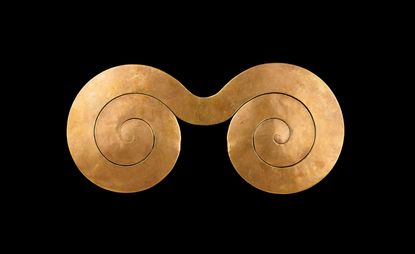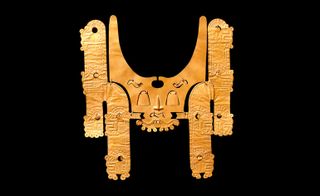Editor’s pick: last chance to see the MET’s mesmerising array of ancient American gold
Boasting legendary New York sculptor and jeweller David Yurman as its partner, ‘Golden Kingdoms: Luxury and Legacy in the Ancient Americas’ at the New York MET adds to a growing appreciation of precious metalwork beyond decorative impact. The power of these exquisitely crafted precious materials to exalt the wearer and onlooker beyond the everyday was more significant than inherent value. A glorious paean to ancient goldworking techniques, this week presents a last chance to see the exhibition. Usually, you’d have to travel to Colombia to view the jaw-dropping additions from Bogotá’s famed Museo del Oro, so we think that the sizeable collection on show here is well worth bringing to your attention. The exhibition is on view at The Met Fifth Avenue, Gallery 199 until 28 May. We’ve pinpointed some of our favourite pieces:

‘At the beginning of our relationship, my wife Sybil and I would frequently visit the Museum for creative inspiration. My fascination with ancient jewellery became the catalyst to make historical forms contemporary.’ – David Yurman

Tolima gold pendant, Colombia
1 B.C.–A.D. 700 (32 × 16.2 cm)
The exhibition presents spectacular finds from recent archaeological excavations – crowns, pectorals, pendants, necklaces, ear and nose ornaments, labrets, masks, mantles, goblets, vases, stelas, bells, painted books, and more – that have rarely, if ever, left their country of origin.

Gold Malagana nose ornament, Cauca Valley, Colombia
100 B.C.–A.D. 300 (28 × 25.5 cm)
‘In the ancient Americas, precious objects were designed to provoke a powerful response – perceptually, sensually, and conceptually. This speaks to me as a designer and an artist.’ – David Yurman

Gold Cauca Bird-Man pectoral, Colombia
A.D. 900–1600 (16.5 × 13.3 × 2.1 cm)
This chest ornament, one of the largest and most ornate cast-gold works known from the ancient Americas, depicts a man with avian attributes. Two small lizard-like creatures, shown in profile, perch on the figure’s wings. The wax model was carefully incised to show details such as the texture of the creatures’ skin and feet.

Gold and platinum Calima-Yotoco jaguar-shaped lime container, Cauca Valley, Colombia
100 B.C.–A.D. 800 (6.6 × 13.5 cm)
The thin spoon with a finial, inserted between the feline’s shoulder blades, would have been used to retrieve powdered lime. Works were relatively small in scale, which meant they could be transported over vast distances as royal gifts or sacred offerings.
Wallpaper* Newsletter
Receive our daily digest of inspiration, escapism and design stories from around the world direct to your inbox
Caragh McKay has been a contributing editor at Wallpaper* since 2014. She was previously watches & jewellery director and is currently our resident lifestyle & shopping editor. Caragh has produced exhibitions and created and edited titles for publishers including the Daily Telegraph. She regularly chairs talks for luxury houses, Van Cleef & Arpels and Cartier among them. Caragh’s current remit is cross-cultural and her recent stories include the curious tale of how Muhammad Ali met his poetic match in Robert Burns and how a Martin Scorsese film revived a forgotten Osage art.
-
 The best fashion moments at Milan Design Week 2024
The best fashion moments at Milan Design Week 2024Scarlett Conlon discovers the moments fashion met design at Salone del Mobile and Milan Design Week 2024, as Loewe, Hermès, Bottega Veneta, Prada and more staged intriguing presentations and launches across the city
By Scarlett Conlon Published
-
 LEVC’s L380 is a truly magnificent minivan
LEVC’s L380 is a truly magnificent minivanThe London Electric Vehicle Company’s L380, is a magnificent minivan designed for upscale long-distance travel, as the maker of the London Taxi branches out into all-purpose EVs
By Jonathan Bell Published
-
 Enjoy ocean and jungle bliss at Bespoke Tulum’s residences in Mexico
Enjoy ocean and jungle bliss at Bespoke Tulum’s residences in MexicoBespoke Tulum is an exclusive hospitality complex designed by Muro Rojo Arquitectura on Mexico’s Caribbean coastline
By Sofia de la Cruz Published